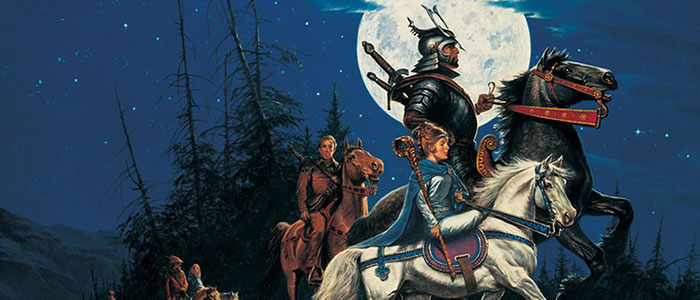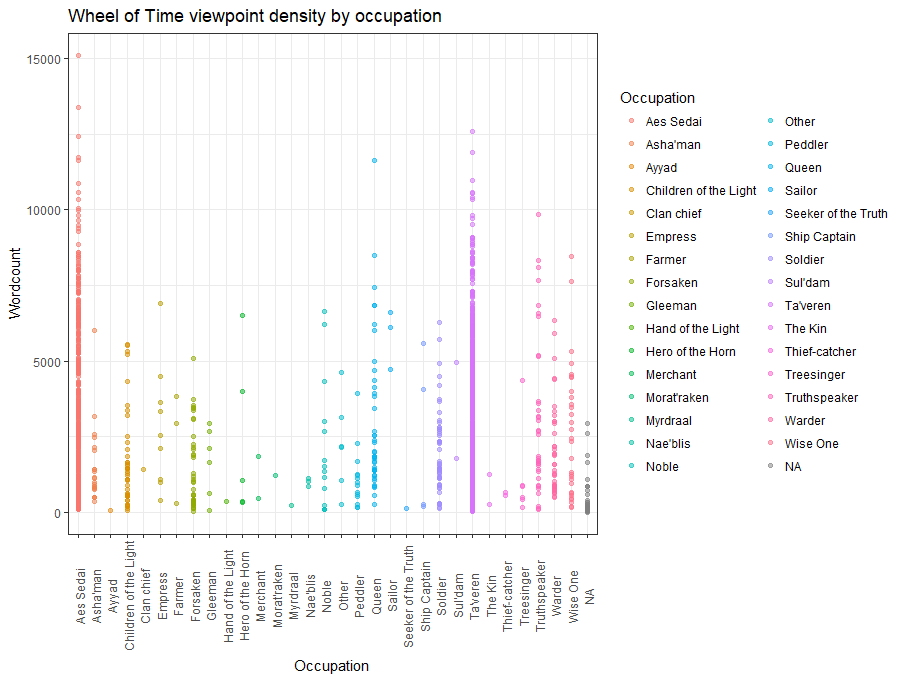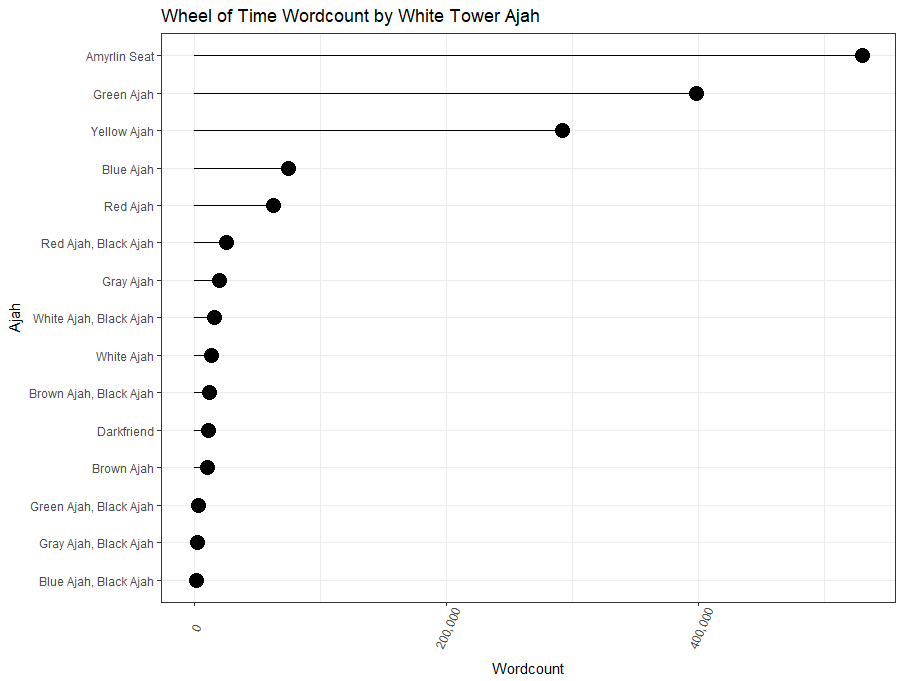A Statistical Analysis of Robert Jordan’s The Wheel of Time

If you’ve arrived here by traveling any logical path, you need no introduction to Robert Jordan’s The Wheel of Time books, a series that, across 14 door-stopping tomes, seized upon the imaginations of hundreds of thousands with its sprawling scope, mountainous stakes, and scrupulous detail.
The Eye of the World (The Wheel of Time Series #1)
The Eye of the World (The Wheel of Time Series #1)
Paperback
$19.49
$21.99
And if you’re anything like me, the story of the Two Rivers ta’veren forever changed your understanding of the relationship between the written word and the possibilities of storytelling. It also peeled the cellophane off the greater fantasy genre, and enabled me to peek at what other literary treats lay within.
But I’m not here to gush over this colossal pillar of sword and sorcery. I’m here to talk about, and attempt to comprehend, its size. Weighing in at over 4 million words, The Wheel of Time books are assuredly among the longest fantasy series out there, although reliable data on the matter is elusive; Wikipedia suggests it is some 1 million words longer than The Malazan Book of the Fallen, its chief competition for the honor (omitting shared universe tales like those of Mercedes Lackey and L.E. Modesitt, as well as those that spread a story across multiple trilogies).
And if you’re anything like me, the story of the Two Rivers ta’veren forever changed your understanding of the relationship between the written word and the possibilities of storytelling. It also peeled the cellophane off the greater fantasy genre, and enabled me to peek at what other literary treats lay within.
But I’m not here to gush over this colossal pillar of sword and sorcery. I’m here to talk about, and attempt to comprehend, its size. Weighing in at over 4 million words, The Wheel of Time books are assuredly among the longest fantasy series out there, although reliable data on the matter is elusive; Wikipedia suggests it is some 1 million words longer than The Malazan Book of the Fallen, its chief competition for the honor (omitting shared universe tales like those of Mercedes Lackey and L.E. Modesitt, as well as those that spread a story across multiple trilogies).
In short, this thing is massive, and what I endeavor to do in the following space is understand how Robert Jordan (and later Brandon Sanderson) dispensed those 4.4 million-odd words. How did word distributions to his characters change over time? If you’re still reading, I bet you already know the story well. By the end of this, you’ll know it by the numbers.

Wordcount
Let’s start top level and thread our way down from there. Here’s a look at wordcount over time by the individual book. The median book length for the full series is represented by the dotted line.
Interestingly enough, what Jordan put forth lengthwise with Eye of the World was a pretty good indication of how the rest of the series would fall out. Not bad, considering at that point both he and Tor thought it was going to be a trilogy (*pause for polite laughter*). Books 4 through 6 easily represent the heftiest segment of the series, and then there’s a very clear pattern of gradual increase from Path of Daggers all the way through A Memory of Light.
One of the more interesting datapoints I found while analyzing this information was the length of the chapters through The Wheel of Time. First, here’s the chart. I’ll diagnose below.
As pointed out in the axis labels, the horizontal (x) axis represents chapter length in words, and the y axis represents how many times throughout the books a chapter of that length occurred. The red vertical intercept here represents the series’ average chapter length, which is around 6,000 words. Note that this marker occurs in the middle of the primary distribution, or hump (or Dragonmount?), but then the distribution tails off to the right with several ticks on the histogram. This verifies something that we all knew: if Jordan wrote an outlier chapter, it was likely a long one, not a short one.
Astute readers may have picked up on a missing data point in the above plot. Nicely done. In Memory of Light, the long-awaited chapter The Last Battle registered a staggering 81,200 words, whereas the x-axis on the above chart is cut at ~20,000. For some perspective, Harry Potter and the Sorcerer’s Stone was around 78,000 words in its entirety. But we’ll get to that chapter in a moment.
This chapter wordcount data becomes more interesting when we facet the information by book. See below.
This is a lot of information at a glance, so I’ll distill a few salient observations.
- Eye of the World was one of the more normally distributed book in terms of chapter wordcount, which essentially means it had a most-common chapter length and a comparable number of chapters that were longer or shorter.
- The Dragon Reborn was right-skewed, which means there was a heavy distribution of exceedingly long chapters.
- Winter’s Heart was the most homogenous, or consistent, in chapter length.
Alright, now to demonstrate to what degree of immensity The Last Battle was an outlier in the series.
Direct your attention to the final panel in this grid, and then all the way to right of that. There it is, Tarmon Gai’don, represented as a tiny green speck. Cute, isn’t it?
While we’re zoomed out, let’s take the opportunity to examine these outlier chapters over time. You can see that the first real eye-openingly long chapter occurred in Lord of Chaos, and then Jordan braked on the megachapters for a couple books. But Winter’s Heart, Crossroads of Twilight, Knife of Dreams, and Memory of Light all had at least one instance of a chapter that was 15,000 words. Robert Jordan (and his publisher) clearly became more comfortable with this departure from convention over time, and then Brandon Sanderson was also allowed to dip into the well.
Chapter length information is a bit dense, so let’s delve into something more colorful.

Gender Analysis
I’ll start with a plot, which visualizes the percentage of words written from the viewpoint of a given gender by book.
Note: the “NA” points refer to scenes that are either quotes, passages from in-world texts, or narrator viewpoints with no gender specified.
The story here is lucid. Eye of the World was dominated by male viewpoints, but women began reclaiming viewpoint-share in The Great Hunt, and by the end of the series had the better of it.
We’ll come back to viewpoints shortly, but first let’s zoom this view back out to wordcount. After all, if one character received ten viewpoints, all at 100 words of length, and another character received one viewpoint of 5,000 words, that allotment clearly favors the latter.
Now we can specifically see that men received more words during the first four books, and then were first eclipsed during Fires of Heaven. Men and women received an extremely similar number of words during The Lord of Chaos, and then women collected the lion’s share of words for six consecutive books, before men handedly pocketed more words for the series’ final two installments.
Aran’gar, the Forsaken who originally inhabited the body of a male, but after death was corporeally returned as a female, received viewpoint scenes in Path of Daggers and Knife of Dreams.

Viewpoint Analysis
We analyzed chapter length earlier, but looking at viewpoint, defined as a period of text that is narrated by the same character, might be interesting. Many, if not most, of The Wheel of Time is populated with chapters that contain multiple viewpoints.
Robert Jordan actually started the series off with the second highest average viewpoint length of the full saga, before things levelled out between The Great Hunt and Winter’s Heart. Then there was a bit of a paradigm shift back to long viewpoints during Crossroads of Twilight and Knife of Dreams, which likely contributed to those books’ reputations for being more sloggy than their counterparts. Then Sanderson reeled the line back in, as Towers and Midnight and Memory of Light closed Rand’s story out with the two fastest-paced books of them all.
One callout here: Crossroads of Twilight had an average viewpoint length that was six times greater than that of A Memory of Light.

Cultural Analysis
The diverse fabric of Jordan’s world, affectionately monikered as Randland by its fans, populated by people of all color and culture and circumstance, was a principal contributor to its verisimilitude. Jordan never hesitated to tell you where in his world a new face was from. So, to which cultures did he dedicate the vantage point?
Ah, well, I suppose we could have seen that coming, given that his six principal viewpoint characters – Rand, Mat, Perrin, Egwene, Elayne, and Nynaeve—are all Andoran. To denude information about the other regions, let’s simply remove Andor from the plot.
I found it interesting that we get more words from characters with no specified nationality than we do from any given nationality apart from Saldaea and Andor. I suspect this largely has to do with the fact that none of the Chosen have origin nationalities specified. Of course, an argument can be made for Rand’s wordcount being bucketed as Aiel.

Occupation Analysis
From the mundanities of farming or vending wares to the court intrigue of nobility to the high magic of the Aes Sedai and Forsaken, we got a glimpse of life in Randland from top to bottom. Statistically, it looked like this.
A few pointers on reading this: height on the y axis does not mean that there were a lot of viewpoints for that occupation, it means those individual viewpoints were long. For instance, we can see that the longest single viewpoint in the series was a tick over 15,000 words, and was told from the point of view of an Aes Sedai. Density indicates volume. The purple streak is ta’veren, which is how I segmented Rand, Mat, and Perrin, so as to keep the rest of the data unmuddied.
What we see is a high volume of scenes from Aes Sedai, which probably comes as no surprise, with notable contributions from the Children of the Light, Forsaken, Queens, Soldiers, Warders, and characters with no specified occupation.

Ajah Analysis
And one final view of the wordcount distribution amongst our fatally fractured White Tower.
My favorite part of this is that Black Ajah Aes Sedai who were masquerading under white shawls received more words than the legitimate White Ajah. The same can be said of Brown Ajah, thanks to Verin Mathwin.
So there you have it. Over 14 books the numbers raise some interesting questions. Was the story truly about Rand al’Thor’s transition from sheepherder to savior, or was it a tale of political infiltration in the world’s most magical court? It was, of course, both of those things and so much more, and I am reminded (as if I’d ever forgotten) what a sparkling treasure we had in Robert Jordan.
All data scrubbed from the WoT Wikia.[/ean]











